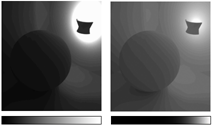Exposure controls are plug-in components that adjust the output levels and color range of a rendering, as if you were adjusting film exposure.
The exposure control process is known as tone mapping. These controls are especially useful for renderings that use radiosity or that render high-dynamic-range (HDR) imagery.
Exposure control compensates for the limited dynamic range of computer displays, which is typically about two orders of magnitude: The brightest color that appears on a display is about 100 times brighter than the dimmest. The eye, by comparison, can perceive a dynamic range of about 16 orders of magnitude. In other words, the brightest color we can perceive is about 10 million-billion times brighter than the dimmest. Exposure control adjusts colors so they better simulate the eye's great dynamic range, while still fitting within the color range that can be rendered.

Left: Linear exposure control maps intensity evenly.
Right: Logarithmic exposure control maps most intensities to low and mid tones.
Tips:
- If the primary lighting from your scene comes from standard lights (rather than photometric lights), use the Logarithmic exposure control and turn on Affect Indirect Only.
- Use Automatic exposure control for rendering still images. This method is also useful for first-draft renderings.
- Use Logarithmic or one of the advanced exposure control for animations with a moving camera. Automatic and Linear exposure control with a moving camera can cause excessive flickering.
- For outdoor scenes that use the Daylight system, turn on the Exterior toggle to prevent overexposure.
- When using an OCIO-based mode for color management, the tone map is provided by the view transform. In general, it's best to use <no exposure control>. For more details, see Exposure and Color Management.
Exposure and Attenuation for Standard Lights
When you use standard lights that are not attenuated, renderings tend to have a low dynamic range, because light intensities don't vary greatly across the scene. In this situation, adjusting light values might be all you need to do to get a good rendering.
On the other hand, when lights are attenuated the illumination might be too bright on near surfaces or too dim on distant surfaces. In this situation, the Automatic exposure control can help, because it adjusts the larger dynamic range of the (simulated) physical scene, into the smaller dynamic range of the display.
